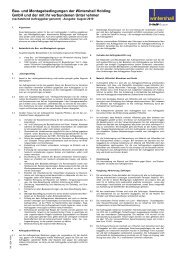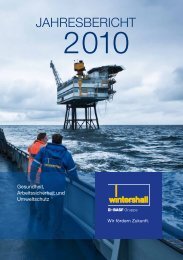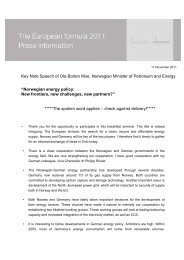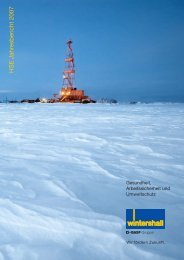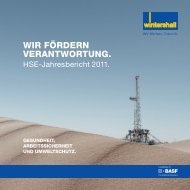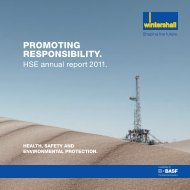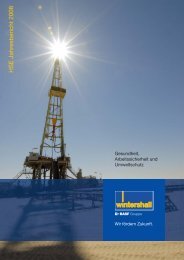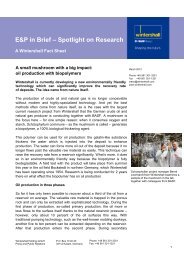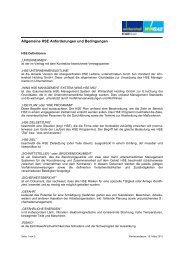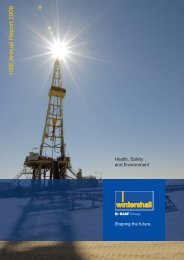HSE Annual Report 2010 (English) - WINTERSHALL
HSE Annual Report 2010 (English) - WINTERSHALL
HSE Annual Report 2010 (English) - WINTERSHALL
You also want an ePaper? Increase the reach of your titles
YUMPU automatically turns print PDFs into web optimized ePapers that Google loves.
FRACING: A WORLDWIDE PROvEN TECHNOLOGY.<br />
various factors determine how fast and for how<br />
long oil or gas can be produced from a reservoir,<br />
including the geological structure of the reservoir,<br />
the porosity and permeability of the reservoir rock,<br />
and the consistency and viscosity of the hydrocarbons<br />
it contains.<br />
Special techniques are required to extract oil or gas<br />
enclosed in extremely impermeable reservoir rock.<br />
Alongside horizontal drilling, hydraulic fracturing<br />
has been in use around the world for decades and<br />
is being improved all the time. The technique is<br />
used to exploit high-density reservoirs which lie<br />
deep underground.<br />
The process involves injecting water at high pressure<br />
at previously defined points into the solid rock<br />
layers to create fine millimeter-thin cracks in the<br />
rock. Sand mixed with the water (proppants) helps<br />
to keep these cracks open longer. The cracks make<br />
it easier for the hydrocarbons in the reservoir to flow<br />
toward the well for production. This method has<br />
also been used for decades in Germany in crude<br />
oil and gas production from conventional reservoirs,<br />
in drilling for hot water or, in recent years, in geothermal<br />
drilling.<br />
99 % of the fluid mixture used in fracing comprises<br />
water and sand, with around 1% being made up of<br />
chemical additives to ensure that silica sand, for<br />
example, blends with the water. The deliberately<br />
created flow channels stay open long enough and<br />
bacteria do not enter the reservoir. Apart from the<br />
natural seal due to the pressure from the mighty<br />
weight of the several hundred meter thick overlying<br />
rock, usually consisting of clay or salt layers, the<br />
well’s system of steel pipes, which are cemented<br />
into place, form secure barriers against the waterbearing<br />
aquifer layers.<br />
For several decades now, Wintershall has used fracing<br />
to produce crude oil and gas, mostly in tight gas<br />
deposits in Russia, Argentina, the Netherlands and<br />
Germany, with high safety and environmental standards<br />
– without any impact on the environment.<br />
HEALTH SAFETY ENVIRONMENT<br />
Fracing facility drilling hole Leer Z4 in Germany



